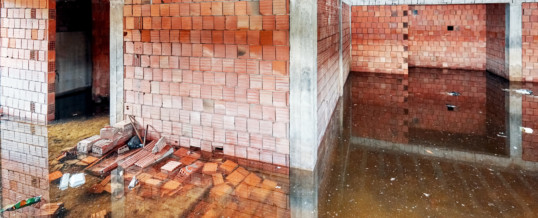
Picture this: it’s one of those rainy Sunday afternoons that is perfect for curling up under a blanket with hot coffee and a great book. You’re enjoying every moment of it until you happen to walk into your basement.
You find water covering the floor. Suddenly you’re spending your Sunday scooping water out of the basement and trying to salvage your belongings.
All of this can be avoided with the right exterior and interior basement waterproofing. Before you dive in, take a look at some of the different approaches and methods we use.
1. Preventing Window Leakage
One of the most common ways to get flooding in your basement is for water to come in through the windows. This tends to happen when water pools in the window well and seeps in.
A key way to resolve this problem is with a window drain. A window drain is a specialized system that drains water out of these window wells. We run the water through a basement waterproofing system that takes it to a sump pump and keeps it away from your home.
It’s also a good idea to find out if there is a reason why water is pooling in your window well in the first place. Check where your outdoor spouts go to see if they’re pushing water toward your window. You may need to extend your downspout for better results.
2. Blocking Water’s Access to the Stairs
In addition to windows, another common way water gets into basements is through outdoor stairwells.
You may have a stairwell that leads to a basement door. When water gets into the bottom of the stairwell, it puddles until it gets high enough to get into the door.
While getting a better seal on your basement door is part of the solution, you also want to keep the water from puddling in the first place. We do this by installing a stairwell drain.
As simple as it sounds, this drain sits at the bottom of your stairwell. Before water can build up enough to reach your door, the drain pulls the water into a drainage system. The water can go to a dedicated sump pump instead of into your basement.
3. Lining the Walls
When a military is fighting a battle, they have several waves of soldiers so that if one can’t hold back the enemy, the next one can. When you’re at war to keep water out of your basement, you want to take the same approach.
While strategies like window drains can help, there are other ways water could get into your basement. This is why wall liners are so helpful.
A wall liner goes along the interior wall of your basement. It’s a waterproof blockade so that if any water gets in, it stays around the perimeter of your basement instead of coming in and damaging your basement.
The wall liner alone isn’t going to keep your basement damage-free. Its real purpose is to work with a drainage system we install around the edge of your basement. The wall liner pulls water into that drainage system instead of letting it into the basement.
4. A Dedicated Basement Drainage System
You’ll notice that all the waterproofing strategies above have something in common: a drainage system. You can’t just block water from coming in. You need to give it somewhere to go.
That’s where a drainage system comes in. Your basement needs to have a network of channels below the floor with drains that pull water into the channels.
Those channels should lead to a sump pump to get the water out of your home. Depending on the size of your basement and the amount of flooding you tend to have, you might need multiple sump pumps.
5. A Multi-Faceted Approach
As we mentioned, the best approach to basement waterproofing is a multi-faceted approach. This is especially true if you don’t know how water is getting in, or if it’s coming in through multiple areas.
Your basement’s dryness is nothing to fool around with. In truth, the best way to waterproof your basement is with a combination of the strategies above. They all work together well to give you the dry and functional basement you want.
How Do I Know What My Home Needs?
Every home is unique when it comes to their basement waterproofing needs. At the end of the day, the only reliable way to know what your home needs is to get input from a professional.
A basement waterproofing specialist will be able to inspect your home and your water damage to see where the water is most likely to come in. Then we can design a solution that fits your basement’s needs.
Chances are that this will involve a combination of a few different solutions. While a drainage system is the most effective waterproofing method, we typically also provide ways to block the water from getting in in the first place.
Before you do this, though, take time to gather your observations. While basement waterproofers can sometimes get a lot of information from your water damage, any other information you have is helpful.
In particular, head to your basement the next time it rains. Where does water appear to be coming in from? Where does it seem to puddle the most?
All those answers can help us design the best solution for you.
The Next Steps Toward Exterior and Interior Basement Waterproofing
Now that you have a picture of how exterior and interior basement waterproofing works, how do you get it for your home?
It all starts with a phone call. Call our basement waterproofing specialists today to schedule your free inspection and find out how we can help you stay dry.
ShareDEC
